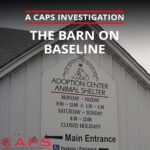Breeder: Dennis and Donna Van Wyk
Business name: Prairie Lane Kennel
Address: 1955 120th St.
City, State Zip: New Sharon, IA 50207
Year: 2015
USDA License: 42-A-0331
Date of CAPS Investigation: 03/23/15
Time of CAPS Investigation: 11:00am and 6:30pm
CAPS investigation: 03/23/15; kennel visited at about 1100 and 1830
Weather at time of investigation: 34 degrees Fahrenheit and overcast
Approximate number of dogs observed at time of investigation: 45 dogs, 4 puppies
Breeds: Rottweilers, Sherman Shepherds, Pekingese, Schnauzers, Lhasa Apsos, Beagles, Rat Terriers, Dachshunds, Pugs, Pomeranians, Shelties, American Eskimos
Dennis and Donna Van Wyk’s kennel, located 150 feet west of their residence, consisted of three kennel areas. A southern kennel building, with indoor/outdoor dog runs on its north and south side and three additional outdoor runs to its west, primarily housing Rottweilers and German Shepherds. Another kennel building just north of the Rottweiler/Shepherd structure had elevated indoor/outdoor small dog cages. A third, small kennel building west of the small dog building had several dog cages attached to it.
I saw veterinary problems at the Rottweiler/Shepherd building and at the small dog building located to its north.
I went to the property at about 1100 on March 23, 2015, and returned again at about 1830 on the same day. I observed the kennel during my initial visit, and then spoke to Dennis Van Wyk and purchased a puppy from him on my second visit. Several dogs had veterinary conditions. I pointed out the worst, a German Shepherd with an injured ear, to Dennis.
Rottweiler/German Shepherd structure
The primary structure was a small, one-story building with a door on its east side. The north and south side had outdoor runs with concrete floorings and galvanized-wire walls. Wooden beams used to frame the walls were covered in peeling paint (Sec 3.1 Housing Facilities, General (c) Surfaces (1) General requirements). The floorings were covered with what appeared to be several days’ accumulation of dried and wet feces (Sec 3.11 Cleaning, Sanitization, Housekeeping, and Pest Control (a) Cleaning of primary enclosures). Pens held one to two Rottweilers or German Shepherds.
There were also three small dog cages on the north side of this building, set above the large dog pens so that they were suspended over the ground. The northwestern pen held two Rat Terriers, one of which had an enlarged torso and appeared to be pregnant.
There were three more outdoor dog runs to the west of the building that also contained German Shepherds and Rottweilers. The eastern pen of this group held a whelping Rottweiler mother and puppies. I observed two Rottweiler puppies about five weeks of age in that pen. The flooring of the whelping pen was covered in dried feces and piles of fresh feces, reflecting more than 24 hours of accumulation (Sec 3.11 Cleaning, Sanitization, Housekeeping, and Pest Control (a) Cleaning of primary enclosures).
Feces was piled up on the ground around all of the enclosures, as though washed or scraped from the flooring to the outside and left there (Sec 3.11 Cleaning, Sanitization, Housekeeping, and Pest Control (c) Housekeeping for premises).
Injured Dogs
1. The northeastern pen held two German Shepherds, one of which held a front left paw up while limping around the pen (Sec 2.40 Attending Veterinarian and Adequate Veterinary Care (a) Adequate veterinarian care).
2. The adjacent pen, just to the west, held two German Shepherds, one of which had a left ear that was swollen at the base so that it was about twice the size of the right ear. The left ear hung down, and the dog’s head tilted to the left continuously. The dog’s nose was scraped on the end, with an area about a quarter inch wide and 1 1/2 inches long that was raw and bloody (Sec 2.40 Attending Veterinarian and Adequate Veterinary Care (a) Adequate veterinarian care).
Small Dog Structure
North of the Rottweiler/German Shepherd structure was a building with fourteen indoor/outdoor cages suspended above the ground on the building’s southern side. The building had a door on its eastern side, and when Dennis Van Wyk entered the building to get a puppy to show me, I could see whelping cages inside of the building. The cages were made with treated-wire floorings, untreated wire walls, and framed with wooden beams covered in peeling paint (Sec 3.1 Housing Facilities, General (c) Surfaces (1) General requirements). More than two weeks’ accumulation of feces was piled beneath the cages (Sec 3.11 Cleaning, Sanitization, Housekeeping, and Pest Control (c) Housekeeping for premises). Each cage contained two to three dogs of various small breeds.
Injured Dogs
The sixth cage from the west contained three Pekingese. The blonde Pekingese had a right eye that appeared to be either swollen shut or removed (Sec 2.40 Attending Veterinarian and Adequate Veterinary Care (a) Adequate veterinarian care). The orange female Pekingese with a white stomach and white stripe on her head had a left eyelid that was heavily swollen so that the eye was almost completely swollen shut (Sec 2.40 Attending Veterinarian and Adequate Veterinary Care (a) Adequate veterinarian care).
Western Kennel Building
West of the small dog structure was a small building with a doorway on its southern side. This doorway was open at the time I was there, and inside I saw an elevated, occupied Beagle cage at the north wall, though the cage was difficult to see since there was no lighting on in the room. Two elevated indoor/outdoor cages were on the southern side of the building, one containing two Samoyeds and the other containing two Shelties. The cages were made of treated wire and plastic framing.
Interaction with Dennis Van Wyk:
At about 1830, I spoke to a man who identified himself as Dennis Van Wyk (Caucasian male, about 50 years old, 5’8”, 270 lbs, with short blonde and white hair). He said he works for Ideal Ready Mix. When I expressed interest in buying a Lhasa Apso, Dennis offered to sell me a Lhasa-mix puppy that he said was eight months old.
He entered the small dog structure north of the Shepherd/Rottweiler structure and came out with a puppy that appeared to be a Schnauzer mix. The puppy’s fur was soaking wet, and the puppy had a very heavy odor of ammonia, urine, and feces (Sec 3.6 Primary Enclosures (a) General Requirements (2)(v) Enable dogs to remain dry and clean). When Dennis set the puppy down, the puppy’s stomach hugged the ground and he scampered for several feet without standing upright or moving in any particular direction. The puppy did not run in a normal manner or attempt to play with me, indicating he had no experience in doing such things (Sec 3.8 Exercise for dogs). Dennis claimed the puppy’s mother was a Lhasa mix and that the father is a Shih Tzu/Schnauzer mix.
I told Dennis I had been to his property earlier to observe his dogs, and that I noticed the Shepherd with a swollen ear. Dennis claimed the dog was not in that condition earlier in the morning, but after he passed by the injured Shepherd’s run to get the puppy for me, he acknowledged the Shepherd’s condition by saying that he saw her. He did not say if he would or would not give the dog any veterinary treatment.
I returned about an hour later with $75.00 cash and paid Dennis for the puppy. I put my name and address on a USDA disposition record for the sale, and Dennis gave me a receipt for a “male lasa mix pup.”
I named the eight-month-old dog, Teddy. I bathed him and kept him overnight at my motel room. He made no noises at all during the night other than growling once when people yelled outside of our room. He would push his stomach to the ground and remain motionless when I approached him or petted him, but after about two hours he started to follow me. After another hour he moved towards me if I stopped petting him; eventually he pulled on a toy rope with me. Once Teddy started following me, he did not stop and would stay by my side continuously. During the night, he would sit up suddenly and move about the bed if he heard any noise, such as the refrigerator making a ticking sound, water moving through pipes in the walls, or a vehicle engine in the parking lot. Despite briefly wagging his tail a couple times when I would approach him, Teddy did not exhibit typical dog behavior such as tail wagging, barking, or licking.
On March 24, 2015, I took Teddy to Animal Rescue League of Iowa in Des Moines, which took custody of the dog. He is currently living in a foster home and awaiting placement with a permanent family.




